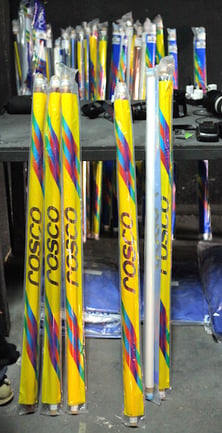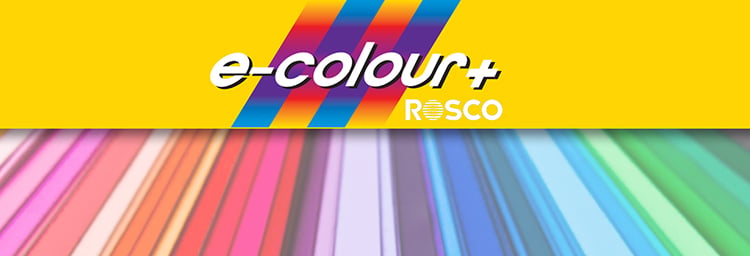Rosco is the world’s largest and oldest color filter manufacturer operating today. Founded more than a century ago, it has developed numerous color filter lines over the years, including Roscolux, Cinegel, Supergel, and e-colour+. In this blog, we turn the lens onto Rosco e-colour+ to answer some of the most common questions posed by lighting professionals about this popular color filter range.
#1 What is Rosco e-colour+?
Rosco e-colour+ is a comprehensive selection of color filters for theatre, film, and television production. It was developed in 1992 and is comprised of color correction, neutral density, color effects, diffusion, and reflection materials. e-colour+ filters are available in 21”x24” (53cm x 60cm) sheets and 48”x25’ (1.22m x 7.62m) rolls, and several e-colour+ materials are now available in wide-width, 60”x20’ (1.5m x 6.1m) rolls.
#2 Is Rosco e-colour+ the same as Lee?
Yes, e-colour+ is essentially the same product as Lee. Both e-colour+ and Lee are derived from the Cinemoid filter system, which was introduced in Europe in the early 1950s by Strand Lighting. Therefore, they share the same name/number/color system. Examples:
- L201 Full CTB is the same as E201 Full CTB
- L250 ½ White Diffusion is the same as E250 ½ White Diffusion
- L210 0.6ND is the same as E210 0.6ND
- L119 Dark Blue is the same as E119 Dark Blue
Moreover, both e-colour+ and Lee filters are manufactured using the same materials and processes. They are both surface-coated polyester films (more about this below). In conclusion, there is an e-colour+ filter to match any Lee filter – just swap the L for an E!
#3 How is Rosco e-colour+ different from Rosco Cinegel?
There are a few differences between the two filter ranges. As noted before, Cinegel and e-colour+ have different name and number systems – a three-digit system for e-colour+ and a four-digit system for Cinegel. There are color differences in their correction filters as well. A Cinegel Full CTB, for example, does not match an e-colour+ Full CTB. That's because Cinegel was originally designed in the United States to match Kodak film standards. e-colour+ filters (and Lee filters), on the other hand, match the AGFA film standards used in the UK and Europe. Although these standards are no longer as important as they once were due to the widespread use of digital cameras, they do explain why the CTO & CTB colors of Cinegel and e-colour+ differ.
#4 What are the advantages of e-colour+ filters?
 |
- Oftentimes, e-colour+ is a more cost-effective and affordable filter solution. Consult a Rosco dealer in your area for pricing.
- All e-colour+ rolls are available on one-inch cores. This is a significant advantage when storage space is at a premium in a warehouse, a truck, or a gel cart. For those who already have trucks, shelves, or carts built for wider rolls, a select range of e-colour+ rolls on two-inch cores is also available.
- The most popular color correction and diffusion filters in the e-colour+ range are available in edge-marked rolls. These rolls feature an imperial measurement marked every foot – making it easy to measure, cut, and keep track of how much gel is left on the roll.
- e-colour+ filters are coated with a flame-retardant solution that meets the BS-3944 flammability standard.
|
#5 Where can I get e-colour+ filters?
e-colour+ filters are available, globally, from five stocking Rosco locations: Stamford, CT; Sun Valley, CA; Toronto, Canada; London, UK; and Madrid, Spain. Contact your favorite Rosco dealer and ask for e-colour+ the next time you’re buying gels.
Visit the e-colour+ product page to learn more about Rosco e-colour+ filters.


